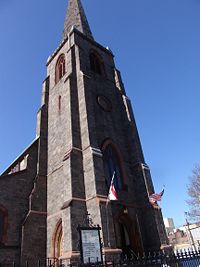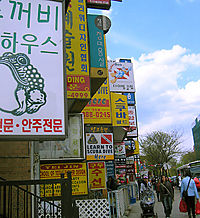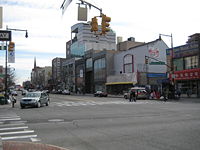From The Peopling of New York City

Founded in 1645, Flushing is a neighborhood located in the northern portion of the borough of Queens in New York City, New York. It lies approximately ten miles east of Manhattan. [1]
Flushing was one of the original Dutch villages on Long Island. Today, Flushing has evolved into one of the largest neighborhoods in New York City and has busy commercial areas as well as quiet, residential neighborhoods. It is part of the Fifth Congressional District which extends into neighboring Nassau County. The area is home to numerous ethnic groups including people of European, Asian, Hispanic and African-American descent. [1]
It is serviced by the 7 train the Q12, Q13, Q14, Q15, Q16, Q17, Q20A, Q20B, Q25, Q27, Q34, Q44, Q48, Q65 and Q66 buses, the Van Wyck Expressway, the Long Island Expressway, Grand the Whitestone Expressway and Grand Central Parkway.
Contents |
Demographics and Statistics
| ACS Demographic and Housing Estimates: 2006 | Estimate | Margin of Error |
|---|---|---|
| RACE | ||
| One race | 2,211,839 | +/-5,430 |
| Two or more races | 43,336 | +/-5,430 |
| Total population | 2,255,175 | NA |
| One race | ||
| White | 1,019,102 | +/-12,569 |
| Black or African American | 432,815 | +/-7,605 |
| American Indian and Alaska Native | 9,243 | +/-2,061 |
| Asian | 477,390 | +/-4,540 |
| Native Hawaiian and Other Pacific Islander | 332 | +/-240 |
| Some other race | 272,957 | +/-13,915 |
| Two or more races | ||
| White and Black or African American | 4,879 | +/-1,073 |
| White and American Indian and Alaska Native | 3,850 | +/-1,959 |
| White and Asian | 3,781 | +/-1,140 |
| Black or African American and American Indian and Alaska Native | 4,025 | +/-2,223 |
Religious Pluralism
- Main article: Religious Pluralism in Flushing
Prior to the surge of contemporary immigration, Flushing was predominately a white, moderate-to-middle-income area whose residents were of Jewish, Irish, Italian, and German ancestry. In fact, during as recent as the 1960s, approximately 97 percent of the population in Flushing was non-Hispanic white.[3] All of this changed with the coming of the White Flight in the 1970s.
The exclusivity of the neighborhood remained in place until only recently. Before the 1970s, nonwhites were not welcomed into the neighborhood. For example, one long-time Chinese resident, who was married to a white American, recalled her experience about finding housing in Flushing. After arriving in 1946 to join her husband in Jamaica, Queens, they decided to move to Flushing. Quite different from the largely Asian Flushing today, she actually had to send her husband to Flushing to look for housing because, as she puts it, "...they [whites] didn't want to see Chinese here. At that time, there were few Chinese around in the community. I was not the only one, but there weren't' many...." Moreover, she also recalls that the business district in Flushing had only one Chinese restaurant and one Chinese laundry in he early 1960s.[3]
Flushing is now home to a large number of ethnic enclaves including those belonging to Chinese, Taiwanese, Korean, Filipino, Indian, and Hispanic immigrants.[4]
As of 2000, more then half of Flushing's population is Asian American, with the largest ethnic Chinese community in the New York metropolitan area, ahead of Manhattan's Chinatown. It is the second-largest Chinatown in United States. Flushing is also home to significant Hispanic American, African American, South Asian, Korean, and Southeast Asian populations.[5]
In fact, since the Immigration Act of 1965, Queens has remained one of the most diverse county in the country.[6] Moreover, it can also be argued that Flushing is one of the most religiously diverse neighborhoods in the United States. This is illustrated by the number and the variety of houses of worships found within Flushing. Walking through Flushing, one could find the colonial Dutch Quaker Meeting House, St. George's Episcopal Church, the Flushing Free Synagogue, St. Andrew Avellino Roman Catholic Church, St. Nicholas Greek Orthodox Church (the largest Greek Orthodox Church in the United States), and a plethora of modern Hindu, Buddhist, and Sikh temples.[7]
Cultural Institutions
- Main article: Cultural Institutions in Flushing
Flushing is one of the most culturally rich neighborhoods in New York City. This northern Queens neighborhood is known for everything from its references in popular culture, to its diversity.
Queens College
History
Queens College in Flushing, Queens, opened its doors in 1937 with the goal of offering a first-rate education to talented people of all backgrounds and financial means. Part of the City University of New York (CUNY) since its founding in 1961, Queens College is one of CUNY’s largest senior colleges. Often referred to as “the jewel of the CUNY system,” the college enjoys a national reputation for its liberal arts and sciences and pre-professional programs. [8]
Queens College has had a chapter of Phi Beta Kappa since 1950 (fewer than 10 percent of the nation’s liberal arts colleges are members of Phi Beta Kappa, the nation’s oldest and most respected undergraduate honors organization). In 1968, Queens College became a member of Sigma Xi, the national science honor society. The American Association of University Women includes Queens College in its list of approved colleges for membership. [8]
Mission
Queens College prepares students to become leaders of our global society by offering a rigorous education in the liberal arts and sciences under the guidance of a faculty dedicated to both teaching and research. Students graduate with the ability to think critically, address complex problems, explore various cultures, and use modern technologies and information resources. With a faculty and student population that reflects the exuberant diversity of New York City, Queens College provides an unusually rich education. [8]
Students
The college’s achievement-oriented and hard-working students, who are likely to have graduated in the top 25% of their high school class, come from over 140 different countries. [8]
- Enrollment: 18,494
- 14,384 undergraduates: 60% attend full-time
- 4,110 graduate students: 90% attend part-time
Campus and Student Activities
The college is located on a beautiful 77-acre, tree-lined campus surrounding grassy open spaces and a traditional Quad. The completely renovated Powdermaker Hall, the major classroom building, reopened in fall 2003 with state-of-the-art technology throughout. The Benjamin Rosenthal Library, with its soaring, light-filled atrium and distinctive clock tower, features innovations in information retrieval. The college is also expanding its wireless capability, opening new cafés and dining areas, installing plasma boards, updating the Student Union and several other buildings, and embarking on a variety of campus-beautification projects. [8]
Since Queens is a commuter college, it is dedicated to making students feel that the college is their home away from home. There are more than 100 clubs and teams on campus, from the Science Organization of Minority Students to clubs for theatre, fencing, environmental science, and martial arts. The only CUNY college that participates in Division II sports, Queens sponsors 20 men’s and women’s teams and has some of the finest athletics facilities in the metropolitan area. A Child Development Center, staffed by professionals, offers inexpensive child-care services to students with children. A recent honors student at the college noted that “The campus is large, beautiful, and close to home. Also, there are students of so many different ethnicities here. . . . It’s so easy to fit in.” [8]
The college holds courses at several off-campus locations, including the 43rd Street Extension Center in Manhattan and the CUNY Center for Higher Education in vibrant downtown Flushing. [8]
Centers
Queens College has many special centers and institutes that serve the diverse communities in the borough of Queens. These units address pressing social issues, including cancer, AIDS, pollution, and racism; study the changing workplace and workforce; and celebrate the borough's many ethnic communities, including Asians, Greeks, Italians, and Jews. [8]
- Asian American/Asian Research Institute works to integrate the talents of individual faculty and the resources of different institutions within CUNY to create a community of scholars who focus their energies on Asia and the Asian American experience.
- Asian/American Center is dedicated to community-oriented research that analyzes the multicultural diaspora experience of Asians in global and local communities.
- John D. Calandra Italian American Institute fosters higher education among Italian Americans and insures that the Italian-American experience is documented and preserved for future generations. This is accomplished through research, counseling, lectures, symposia, and administering an exchange program with CUNY and Italian universities.
- Center for the Biology of Natural Systems (CBNS) conducts research that analyzes real-world environmental and resource problems and their policy implications. Recent projects include a study of the impact of air pollution on asthma sufferers in the South Bronx and a continuing examination of the health of workers involved in the cleanup after 9/11.
- Center for Byzantine & Modern Greek Studies initiates, supports, and coordinates the teaching of Byzantine and Modern Greek subjects; promotes Byzantine and Neo-Hellenic scholarship and publications; and relates academic research and teaching to the needs and interests of the Greek community of Queens and beyond.
- Center for the Improvement of Education forges links between public schools and Queens College that allow staff from each to perform their primary functions more effectively.
- Through outreach and research, the Center for Jewish Studies serves as a bridge between the academic Jewish Studies program and the community. It offers numerous lectures, concerts, symposia, and performances.
- Equity Studies Research Center develops programs to provide equitable access to education for underserved children and families within the New York City area.
- The Michael Harrington Center for Democratic Values and Social Change promotes public discourse about social issues, advocates for social change, and works in partnerships with others to build a more just society.
- Neuroscience Research Center encourages a collaborative educational and research experience within the field of neuroscience for faculty and students. It works to enhance the research education of students by establishing undergraduate and graduate neuroscience programs, seminar series, symposia, and research-related clubs.
- Joseph S. Murphy Institute Center for Labor, Community, and Policy Studies designs an array of educational services and materials for unions and the public, with an emphasis on enabling rank-and-file workers to play more active and informed roles in their unions, workplaces, and communities.
- Schutzman Center for Entrepreneurship provides the tools and environment for the next generation of entrepreneurs. By connecting students, faculty, alumni, and established entrepreneurs in a collaborative environment, the center encourages the cross-pollination of ideas and inspires the creation of new businesses and leaders who will drive the global economy.
- Taft Institute for Government is a nonpartisan, not-for-profit enterprise dedicated to promoting informed citizen participation in the U.S. and around the world. In 1996 the Institute chose Queens College as the site of its national headquarters. Its programs reflect the conviction that true democracy requires that each new generation of citizens be committed to civic involvement.
The Arts
Queens College is the center for the arts in Queens. The Kupferberg Center for the Visual & Performing Arts—formed in recognition of Selma & Max Kupferberg’s gift of $10 million, the largest single gift received to date by Queens College—includes Kupferberg Center Performances, Godwin-Ternbach Museum, Queens College Art Center, Department of Drama, Theatre, and Dance, Department of Media Studies, the Aaron Copland School of Music, and Louis Armstrong House Museum and Archives. [8]
The college regularly brings world-renowned writers to campus. Authors who have recently presented their works through our Evening Reading Series include Margaret Atwood, E.L. Doctorow, Norman Mailer, Frank McCourt, Salman Rushdie, and Nobel Laureates Orhan Pamuk, Toni Morrison, Doris Lessing, and V.S. Naipaul. [8]
The Center for Jewish Studies offers thoughtful lectures, films, and music and dance performances throughout the year. [8]
Effect on Flushing
Queens College contributed to the diversity of Queens by attracting students from all over the world. Moreover, with the establishment of the college, this aided the process of gentrifying in Flushing. As mentioned in the above sections concerning the arts and the special centers established by Queens College, the college has not only contributed to the diversity of the neighborhood but also, it has worked to promote tolerance in the community.
Map of Flushing
Chinatown in Flushing
- Main article: Chinatown in Flushing
Since the 1970’s “white flight”, Flushing, a once white middle class neighborhood, has undergone a tremendous transformation. Over the course of the 1980’s and 1990’s, Flushing’s and the overall population have boomed; at one point in this era, the rate of Flushing’s population growth was four times that of the rest of New York City [9]. At the same time, there was a marked increase in the population of Chinese immigrants to the United States [3].
One may ask, if there was an influx of Chinese immigration to the City, why is there a creation of a new Chinatown? Many of the neighborhood’s residents are newer immigrants who do not have much in common with the Cantonese speaking majority living in Manhattan’s Chinatown [3].
Flushing’s Chinatown is a relatively new development. It is one of the three neighborhoods in the City that are significant Chinese ethnic enclaves: Brooklyn’s newer Sunset Park and Manhattan’s more established downtown Chinatown are the other two ethnic enclaves.
Economic Competition
- Main article: The economic competition in Flushing
Flushing, as one of the most diverse cities in New York and in the United States, contains a mixture of different business with different ethnic owners. The number of foreigner-owned business is still growing and more flourishing than those of American owners. Therefore, it is hard to see an American store in Flushing.
The main part of Flushing where most business abound is around Main Street and Northern Boulevard. These two streets, actually, are the most active sites in the city. Most of the residents are foreigners and therefore the number of stores owned by the foreigners outnumbers those of American owners by a large number. However, within the foreigner-owned businesses there exists a competition. This competition might be seen in a conflict between ethnicities because even though Flushing is said to be a place of heterogeneity, the city could be seen as divided among the different ethnic groups.
References
- ↑ 1.0 1.1 Flushing, Queens - Wikipedia. Accessed 18 May, 2008.
- ↑ Queens County, New York - ACS Demographic and Housing Estimates: 2006 U.S. Census Bureau. Accessed May 4, 2008.
- ↑ 3.0 3.1 3.2 3.3 Zhou, Min. Chinese: Divergent Destinies in Immigrant New York. New Immigrants in New York. Ed: Foner, Nancy. New York: Columbia University Press, 2001.
- ↑ Queens Community Boards, New York City. Accessed April 28, 2008.
- ↑ Lange, Alexandra. (2006-06-05). Flushing in 2016. New York. Retrieved on 2007-07-05.
- ↑ Quick Demographic Profiles: Queens. The Ecologies of Learning Project - a Project of NEW YORK THEOLOGICAL SEMINARY. NYTS - Ecologies of Learning Project. 4 May 2008
- ↑ A Religious History of Flushing, Queens, From the Flushing Remonstrance until Today, Ronald J. Brown, Sacred City Books, 2007, ISBN 978-0-9795092-0-9
- ↑ 8.00 8.01 8.02 8.03 8.04 8.05 8.06 8.07 8.08 8.09 8.10 Queens College - CUNY. Accessed 21 May, 2008.
- ↑ Flushing: An Urban Neighborhood in Transition . New York and Los Angeles: Politics, Society and Culture. Chicago: University of Chicago Press, 2003.





